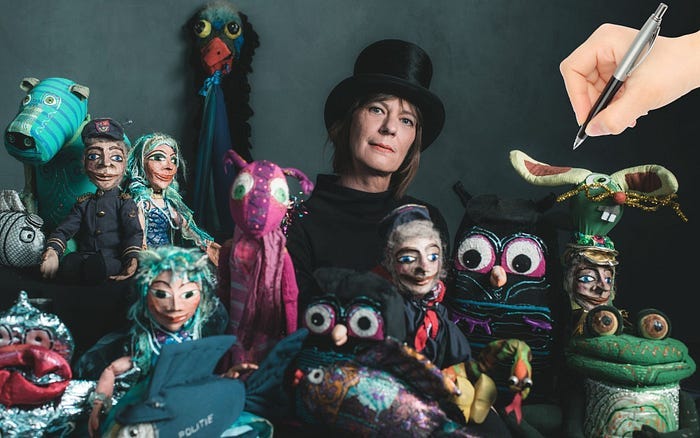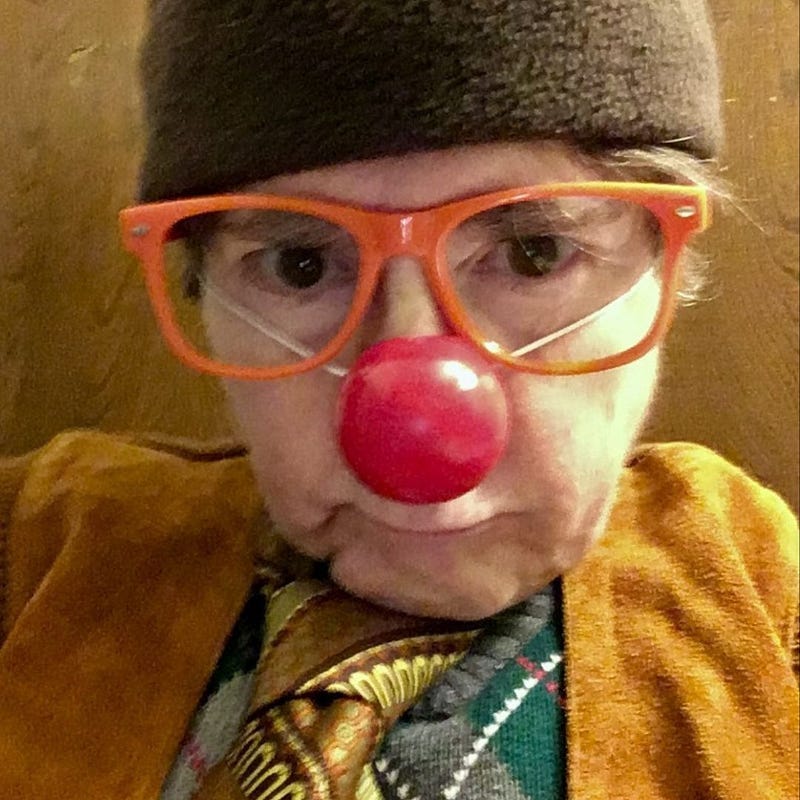Am I Ready to Expand My Environment for Creative Fulfillment?
Or am I too attached to the creature comforts of my home writing space?
Since reaffirming that I’m here to feed my artist’s soul, my surroundings are a big deal.
Up until recently, I assumed my most creative environment was right here at my writing desk, in my bedroom.
Above my desk is a huge bulletin board with healing mandalas I’ve drawn or painted, surrounded by SoulCollage® cards I’ve made over the years. And some handmade rubber-stamped memes.
I’ve also got Frida Kahlo, Kermit the Frog, and William Shakespeare watching over me like a holy trinity of muses. The Father, the Mother, and the Holy Frog? Works for me.
When COVID hit, our SoulCollage® group stopped meeting. Stagebridge — a performing arts school for older adults–-took a hiatus and reopened on Zoom. As did other writing groups and classes.
I now make my SoulCollage® cards digitally so I can easily post them. And attend Zoom classes and workshops right here.
But things are opening up now.
Some classes are staying on Zoom, so they can reach more people. Some are trying out hybrid styles like we do at my church. And a few are in-person only.
Like an upcoming Stagebridge class that calls to me.
It’s called Words to Life.
Here’s the description: “Every week, you’ll spend the first 90 minutes creating a vibrant, new character and a monologue in their voice. Then, you’ll build a realistic puppet to perform your work in preparation for a performance.
By matching traditional writing with puppeteering, this class is a unique opportunity to expand your range as a writer, storyteller, actor, or visual artist. No experience required.”
Characters and monologues, cool! I can always use that.
But what really speaks to my artist’s soul is making and animating those puppets!
Something new, exciting, and a bit scary.
Scary because I’d be without my laptop. My creative umbilical cord. It took a while to get proficient with making stuff up via keyboard, which is way more left-brained than writing by hand.
I’d have to slow way down to read my handwriting. I’d have to print for God’s sake.
I won’t be able to ask my classmates to mute themselves while we all write. There’ll be papers shuffling, coughing, cell phones, and the general din of human bodies in close proximity.
Not to mention the fact that I can’t mute myself and turn on the Chopin nocturns playing as I write these words. How can I possibly be anywhere near as creative in a classroom with fourteen other live bodies?
Maybe that’s exactly what I need to do.
To remind myself, through direct experience, that when we’re in person, there’s an energy exchange going on. We pick up on each other’s vibes and something new gets created synergistically out of that heady milieu.
Just like when we did improv.
I’ve taken several improv classes at Stagebridge. And even brought a friend with early-stage dementia knowing the fun and games would be therapeutic for us both.
And it surely was.
We’re a great team when it came to gibberish poetry. He was a master of gibberish. He could even do spontaneous operatic areas in Italian-sounding gibberish. Amazing to behold. I was blessed to be there to behold.
So he’d recite a poem in gibberish, and I’d translate it to English on the spot. Which means making it up on the spot. I love doing that. I miss doing that.
Then there was the late, great Dr. Reid Davis.
He taught us how to unfold longer stories. Unscripted. Made up on the spot. Trying out characters. Learning to embody them with the way we sat, spoke, and moved through space. Mesmerizing work. I miss him. And again, so blessed to have been there for the magic.
Just like when I discovered Duddles, my somatic clown persona.
Duddles was born at Stagebridge, too.
In a somatic clowning class taught by Clown Conservatory professor Joan Howard. She studied with somatic clown originator, Giovanni Fusetti, over in Italy.
Somatic clown personas grow organically from how our bodies naturally move. Joan had us walk around the room, observing our bodies in motion, exaggerating three movements to define our clown.
Listening to my body, I found myself hunching my shoulders–-nothing new — tucking my chin and turning my feet inward. Melancholy in motion, which felt good to play with.
Every so often I’d honor an urge to stop, look up, throw my shoulders back, lift my chest, and look around, curious about the world. Juicy moments of awe and wonder. I switched back and forth, honoring both impulses in me.
Next came the costumes. My clown selected a pair of baggy plaid pants, a burnt orange vest, a brown cap, and a green tie. Knowing our clowns, we knew what they wanted to wear.
And finally, our naming ritual.
We each stood in front of our fellow clowns listening to brainstormed suggestions till one resonated as true.
It took a while for me. Someone wanted Cuddles. My ears perked up. Close. Very close. Duddles, someone called out. Duddles! Yes, that’s it. Perfect, perhaps because it is only one letter away from Cuddles, in such a so-close-and-yet-so-far kind of way.
The sad clown who so needs a hug filled my heart with joy!
But she hasn’t come out to play since lockdown.
I miss this work that’s more like play. But am I ready for puppet-making?
Master Puppeteer, Julie Taymor is one of my heroes.
She’s best known for designing and directing the stage version of The Lion King. Her amazing puppet masks gave the audience the best of both worlds — her incredibly expressive masks paired with the actor’s expressive faces and bodies.
Taymor studied puppetry in Indonesia and Japan, as well as with Vermont’s Bread and Puppet Theater. She studied mask work in Indonesia as well as Europe, which prepared her for combining the two in The Lion King.
What is it about puppets that’s so compelling?
I grew up with Howdy Doody, Lamb Chop, and Ed Sulivan’s love-struck mouse, Topo Gigio. Puppets had and still have a special place in my heart.
There’s a scene in a movie. Lili, where circus puppets talk a sad girl, Leslie Caron, down from throwing herself off of a tall ladder.
And then there’s Liebe Wetzel.
Liebe tells stories by animating objects such as her father’s polio leg brace. Or a troupe of brassieres, one of whom has breast cancer.
Rather than me trying to explain, watch this:
Liebe Wetzel:"I'm attracted to topics that have to do with silence." - Liebe Wetzel If you were to look up object puppetry in the…ww2.kqed.org
Now signing up for this Words to Life class feels like a no-brainer. Or a left and right-brainer.
You know how Casablanca ends, right?
Bogie kisses Loren Bacal in the fog and says something like, “If that plane leaves the ground and you’re not with him, you’ll regret it. Maybe not today. Maybe not tomorrow, but soon and for the rest of your life.”
Now I’m telling myself, if Words to Life fills up and you’re not in it…
Let me go register now.






History has proven that the pen is indeed mightier than the sword, but what happens when they take away your pen? You speak in other ways.
I love this! Puppets are the best. Maybe because of my age but my attachment to The Muppet Show was major. I've got stories. But this class experience sounds amazing. All in, you have to experience things that inspire creativity in more than just one facet. At least, that's what I believe. I think creativity comes in so many forms, and we are more likely to come up with something truly original and creative if we play with more than one form. Thanks for sharing.